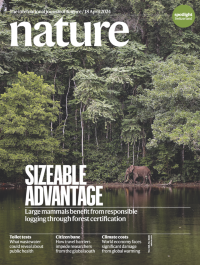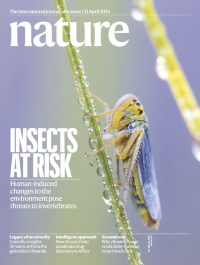Volume 628
-
No. 8009 25 April 2024
Switching channelsTimothy syndrome, a rare genetic disorder characterized by heart defects, autism and epilepsy, is caused by a mutant form of the gene CACNA1C, which encodes a calcium-ion channel. In this week’s issue, Sergiu Pașca and colleagues present a potential strategy for correcting defects caused by the mutation and treating the syndrome. The researchers developed antisense oligonucleotides aimed at decreasing the gene’s use of the protein-coding sequence that carries the mutation in favour of another sequence. They then tested this approach in 3D tissue models — cortical organoids and forebrain assembloids — which they derived from stem cells collected from people with Timothy syndrome. With this proving successful, the team then transplanted the organoids into the cerebral cortex of newborn rats, where they were able to show that treatment with antisense oligonucleotides corrected calcium and nerve cell structural issues caused by the defective gene. The cover features a drone photo of ice patterns that resemble neuron growth.
-
No. 8008 18 April 2024
Sizeable advantageCommercial logging affects more than one-quarter of the world’s tropical forests. The Forest Stewardship Council (FSC) aims to promote sustainable practices to conserve biodiversity through forest management certification. In this week’s issue, Joeri Zwerts and colleagues examine the effects of FSC certification on mammal populations in western equatorial Africa. The researchers captured nearly 1.3 million photos from 474 camera locations in 14 logging concessions. They observed more mammals in FSC-certified forests than in non-FSC areas. The effect was particularly pronounced for large and, often, endangered mammals, such as the African forest elephant pictured on the cover, western lowland gorillas and chimpanzees. The results suggest that where tropical forests are logged, larger and endangered mammals would benefit from FSC certification.
Spotlight
-
No. 8007 11 April 2024
Insects at riskThe cover shows a green leafhopper (Cicadella viridis). Five papers in this week’s issue explore the environmental challenges now facing insect populations, with climate change emerging as a key factor whose influence has potentially been underestimated. Jörg Müller and colleagues analyse 27 years of insect biomass data to reveal that weather anomalies associated with climate change can affect insect biomass in the temperate zone. In a second paper, Melanie Kazenel and co-workers find that warming caused by climate change could pose a threat to bee diversity in the United States, and a paper by Guillaume Ghisbain and colleagues predicts significant reduction in suitable habitat for European bumblebee species owing to human-induced changes to the environment, including climate change. Another human effect is highlighted in a paper by Charlie Nicholson and co-workers, which looks at the negative effects of pesticide use on bumblebees in Europe. And a fifth paper by Roel van Klink and colleagues probes how declines in formerly abundant species can drive insect loss.
-
No. 8006 4 April 2024
Close connectionsHuman physiology is affected by the huge range of microorganisms that make up the microbiome, but the molecular bases for these effects are largely unknown. In this week’s issue, Noah Palm, Aaron Ring and colleagues present an atlas of interactions between human tissues and the microbiota. The researchers devised a system called BASEHIT that uses yeast clones to display human extracellular and secreted proteins (exoproteins), which are then screened for interactions with hundreds of commensal bacteria known to inhabit different tissues in the human body. The resulting interactome revealed thousands of previously unknown molecular-level host–microbe interactions. The cover shows an artist’s impression of one such interaction between a bacterium and a BASEHIT yeast cell.




